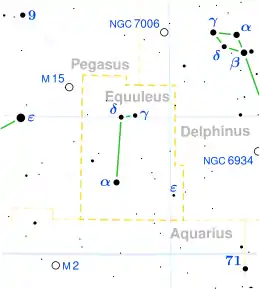Gamma Equulei
Gamma Equulei, Latinized from γ Equulei, is a double star in the northern constellation of Equuleus. It is located at a distance of around 118 light-years (36 parsecs) from Earth and is visible to the naked eye with a slightly variable apparent visual magnitude of around 4.7. The star is drifting closer to the Sun with a radial velocity of −16.5 km/s.[6]
 | |
| Observation data Epoch J2000 Equinox J2000 | |
|---|---|
| Constellation | Equuleus |
| Right ascension | 21h 10m 20.50005s[1] |
| Declination | 10° 07′ 53.6763″[1] |
| Apparent magnitude (V) | 4.58 - 4.77[2] |
| Characteristics | |
| Spectral type | A9VpSrCrEu[3] |
| U−B color index | +0.10[4] |
| B−V color index | +0.26[4] |
| R−I color index | +0.10 |
| Variable type | roAp[5] |
| Astrometry | |
| Radial velocity (Rv) | −16.489±0.0004[6] km/s |
| Proper motion (μ) | RA: 48.74[1] mas/yr Dec.: mas/yr |
| Parallax (π) | 27.55 ± 0.62[1] mas |
| Distance | 118 ± 3 ly (36.3 ± 0.8 pc) |
| Absolute magnitude (MV) | +1.90[7] |
| Details | |
| Mass | 1.78+0.12 −0.17[8] M☉ |
| Radius | 2.11±0.07[9] R☉ |
| Luminosity | 11.0±0.93[9] L☉ |
| Surface gravity (log g) | 4.47[10] cgs |
| Temperature | 7,550±150[9] K |
| Metallicity [Fe/H] | +0.68[10] dex |
| Rotational velocity (v sin i) | 7.0±0.5[8] km/s |
| Age | 1.0[8] Gyr |
| Other designations | |
| Database references | |
| SIMBAD | data |
Properties
The primary component of γ Equulei is a chemically peculiar star with a stellar classification of A9VpSrCrEu.[3] It has a spectrum corresponding to an A9 main sequence star, but with unusual abundances of strontium, chromium, and europium. Stars with this type of spectral peculiarity are called Ap stars. The abundances of some metals are believed to be due to chemical stratification in the slowly-rotating star, unusual for hot main sequence stars. A fairly wide range of spectral types have been published for γ Equulei, ranging from A5 to F1, some of them also indicating unusual abundances of iron in the spectrum.[12] γ Equulei has particularly sharp absorption lines in its spectrum, a sign of very slow rotation.[13]
γ Equulei undergoes rapid periodic variations in brightness, which places it among the rapidly oscillating Ap (roAp) stars.[5] The apparent magnitude varies between extremes of +4.58 and +4.77. It shows pulsations in several periods near 12 minutes. The strongest pulsation is at 11.7 minutes; others are found at 11.9, 12.2, and 12.4 minutes. These are identified as a series of even and odd p-mode (pressure-induced) pulsations.[13]
The surface magnetic field of γ Equulei undergoes slow variation, ranging from +577 G to –1,101 G.[14] Although only 67 years of magnetic field measurements are available, a period of 97.16±3.15 years has been fit to the data. This is thought to be the rotation period of γ Equulei.[15]
γ Equulei has a magnitude 8.69[5] companion at an angular separation of 1.26 arcseconds.[16]
References
- van Leeuwen, F. (November 2007), "Validation of the new Hipparcos reduction", Astronomy and Astrophysics, 474 (2): 653–664, arXiv:0708.1752, Bibcode:2007A&A...474..653V, doi:10.1051/0004-6361:20078357.
- Samus, N. N.; Durlevich, O. V.; et al. (2009). "VizieR Online Data Catalog: General Catalogue of Variable Stars (Samus+ 2007-2013)". VizieR On-line Data Catalog: B/gcvs. Originally Published in: 2009yCat....102025S. 1. Bibcode:2009yCat....102025S.
- Abt, H. A (1985). "Visual multiples. VIII - 1000 MK types". Astrophysical Journal Supplement Series. 59: 95. Bibcode:1985ApJS...59...95A. doi:10.1086/191064.
- Nicolet, B. (1978), "Photoelectric photometric Catalogue of homogeneous measurements in the UBV System", Astronomy and Astrophysics Supplement Series, 34: 1–49, Bibcode:1978A&AS...34....1N.
- Perraut, K.; et al. (February 2011), "The fundamental parameters of the roAp star γ Equulei", Astronomy and Astrophysics, 526: A89, arXiv:1011.2028, Bibcode:2011A&A...526A..89P, doi:10.1051/0004-6361/201015801.
- Soubiran, C.; et al. (2018), "Gaia Data Release 2. The catalogue of radial velocity standard stars", Astronomy and Astrophysics, 616: A7, arXiv:1804.09370, Bibcode:2018A&A...616A...7S, doi:10.1051/0004-6361/201832795.
- Anderson, E.; Francis, Ch. (2012), "XHIP: An extended hipparcos compilation", Astronomy Letters, 38 (5): 331, arXiv:1108.4971, Bibcode:2012AstL...38..331A, doi:10.1134/S1063773712050015.
- Sikora, J.; et al. (February 2019), "A volume-limited survey of mCP stars within 100 pc - I. Fundamental parameters and chemical abundances", Monthly Notices of the Royal Astronomical Society, 483 (2): 2300–2324, arXiv:1811.05633, Bibcode:2019MNRAS.483.2300S, doi:10.1093/mnras/sty3105.
- Perraut, K.; et al. (October 2020), "Benchmarking the fundamental parameters of Ap stars with optical long-baseline interferometric measurements", Astronomy & Astrophysics, 642: 13, Bibcode:2020A&A...642A.101P, doi:10.1051/0004-6361/202038753, A101.
- Koleva, M.; Vazdekis, A. (February 2012), "Stellar population models in the UV. I. Characterisation of the New Generation Stellar Library", Astronomy & Astrophysics, 538: A143, arXiv:1111.5449, Bibcode:2012A&A...538A.143K, doi:10.1051/0004-6361/201118065.
- "gam Equ". SIMBAD. Centre de données astronomiques de Strasbourg. Retrieved 2012-07-27.
- Skiff, B. A (2014). "VizieR Online Data Catalog: Catalogue of Stellar Spectral Classifications (Skiff, 2009-2016)". VizieR On-line Data Catalog: B/mk. Originally Published in: Lowell Observatory (October 2014). 1. Bibcode:2014yCat....1.2023S.
- Martinez, P; Weiss, W. W; Nelson, M. J; Kreidl, T. J; Roberts, G. R; Mkrtichian, D. E; Dorokhov, N. I; Dorokhova, T. N; Birch, P. V (1996). "The p-mode spectrum of γ Equ (HR 8097)". Monthly Notices of the Royal Astronomical Society. 282: 243. Bibcode:1996MNRAS.282..243M. doi:10.1093/mnras/282.1.243.
- Bychkov, V. D.; Bychkova, L. V.; Madej, J. (January 2006), "Secular variability of the longitudinal magnetic field of the Ap star γ Equ", Monthly Notices of the Royal Astronomical Society, 365 (2): 585–589, arXiv:astro-ph/0510529, Bibcode:2006MNRAS.365..585B, doi:10.1111/j.1365-2966.2005.09738.x.
- Bychkov, V. D; Bychkova, L. V; Madej, J (2016). "Periods of magnetic field variations in the Ap star γ Equulei (HD 201601)". Monthly Notices of the Royal Astronomical Society. 455 (3): 2567. arXiv:1510.05160. Bibcode:2016MNRAS.455.2567B. doi:10.1093/mnras/stv2416.
- Eggleton, P. P.; Tokovinin, A. A. (September 2008), "A catalogue of multiplicity among bright stellar systems", Monthly Notices of the Royal Astronomical Society, 389 (2): 869–879, arXiv:0806.2878, Bibcode:2008MNRAS.389..869E, doi:10.1111/j.1365-2966.2008.13596.x.